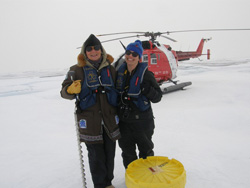Linda White, Institute of Ocean SciencesAugust 31, 2012We study dissolved nutrients to identify different water masses that flow into and out of the Beaufort Gyre--Western Arctic Ocean. On land the important nutrients are nitrogen, phosphorous and potassium but, in the marine environment they are nitrogen, phosphorous and silicate. These nutrients serve similar purposes in both regimes and that is to provide food for phytoplankton or microscopic plants which in turn feed microscopic animals or zooplankton, often referred to as whale food. On station, samples are taken from rosette bottles at different depths. We analyze the samples on a Segmented Flow autoanalyser that measures colour that is developed and detected in a colorimeter. Each sample is compared to a known concentration of each nutrient and in this way we can report the quantity of nitrate, silicate and phosphate in each sample. There are approximately 24 depths where samples are taken at a station and when each depth is measured and plotted on a graph we can see a pattern or profile from the surface to the sea bottom of nutrient concentration. These concentrations represent differing layers of water that are present in the Beaufort Gyre. This information then tells us if the water mass has come from the Atlantic Ocean, Pacific Ocean and the MacKenzie River. Each water mass has different chemical properties some of which are: temperature, salinity, alkalinity, dissolved oxygen and nutrients at depth, to only name a few. It's all about finding out where the water mass is coming from and going to and studying dissolved nutrients helps to unravel some of the mystery. Last updated: October 7, 2019 | |||||||||||||||||
Copyright ©2007 Woods Hole Oceanographic Institution, All Rights Reserved, Privacy Policy. | |||||||||||||||||



